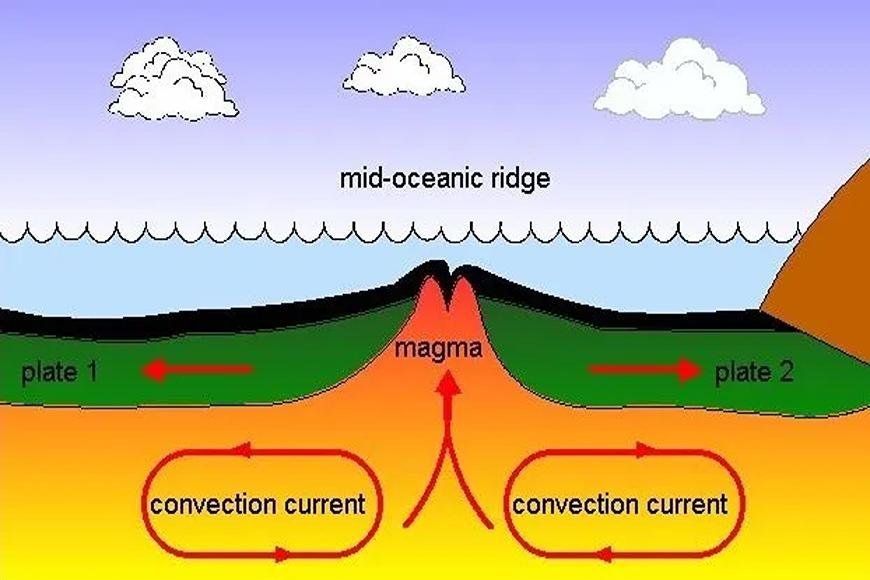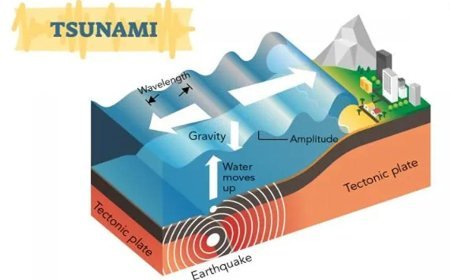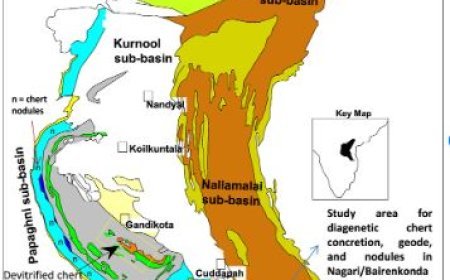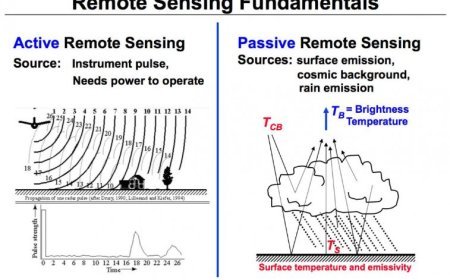SEA FLOOR SPREADING
Birth of Ocean Basins: Seafloor spreading shapes Earth's surface, pushing continents apart.

SEA FLOOR SPREADING
- The process by which new oceanic crust is gradually deposited at the ocean bottom as a result of volcanic activity while older materials are transported away from the mid-oceanic ridge is known as seafloor spreading.
- The mid-ocean ridge is the site of seafloor spreading, which occurs when tectonic plates—large slabs of the Earth's lithosphere—split apart. In 1960, American geophysicist Harry H. Hess proposed seafloor spreading.
- Using sonar, Hess was able to scan the ocean floor and locate the mid-Atlantic ridge (mid-ocean ridge).
- He also noticed that the temperature at the mid-Atlantic ridge was higher than the temperature at the surface farther away.
- He believed that magma oozing from the ridge was to blame for the high temperature.
- This concept of the earth's surface changing supports Alfred Wegener's 1912 Continental Drift Theory.
The Process of Sea Floor Spreading
- A new oceanic crust is generated at the mid-ocean ridge.
- The oceanic crust is made up of rocks that move away from the ridge when new crust is formed.
- Convection currents pull molten material (magma) from the mantle, resulting in the formation of the new crust.
- When molten lava reaches the marine crust, it cools and pushes the existing rocks in both directions away from the ridge.
- The ocean bottom then expands due to the formation of a younger oceanic crust.
- The new rock is thick, although not as dense as the older rock sliding away from the crest.
- As it travels deeper, the granite becomes colder and denser, either reaching an ocean trench or continuing to spread.
- The successive migration of the stones from the ridge is supposed to gradually raise the water depth and produce deeper ocean tunnels.
- The ocean floor is replenished every 200 million years, allowing for the creation of a mid-ocean ridge, migration across the ocean, and subduction into a trench.
The Subduction Process
- The exceptionally thick oceanic crust that arises as a result of progressive spreading will either sink or float.
- It can be subducted into the deep ocean trench or spread out till it reaches the land.
- Subduction is the downward movement of the edge of one crustal plate into the mantle under another.
- When an exceptionally thick ocean crust collides with a deep ocean trench, this happens.
- Subduction, on the other hand, will not occur if the ocean crusts continue to move across the ocean without coming into contact with a trench.
- It will continue to spread until it comes into contact with a shore, at which time it will physically push it away in the other direction.
- Subduction of the ocean crust can occur in two ways. Melting happens as a result of strong friction following subduction. After that, the oceanic crust melts and turns into lava.
- The magma may either return to the mantle, forming fresh convection currents and expanding the sea bottom, or it might burst through a fracture in the continental crust, becoming a volcano.
- Subduction and sea-floor spreading are natural processes that have the ability to alter the size and form of the ocean.
- Because of its few trenches, the Atlantic Ocean, for example, is assumed to be expanding.
- As a result, the bottom of the Atlantic Ocean continues to expand, linking it to other continental crusts and driving the ocean to become broader over time.
- The Pacific Ocean, on the other hand, has more trenches, which results in greater ocean crust subduction rather than the formation of the mid-ocean ridge.
- The Pacific Ocean is projected to contract much further.
Evidence of Sea Floor Spreading
- Several pieces of information had been acquired to back up Harry Hess' thesis about seafloor spreading.
- Molten material studies, seafloor drilling, radiometric age dating, fossil ages, and magnetic stripes all contributed to this evidence.
- This evidence, however, was also used to support the notion of continental drift.
1. Molten material
- When Hess began charting the water, he noticed higher temperatures around the mid-Atlantic ridge, leading to his demonstration of molten material beneath the ocean.
- The status of the mid-oceanic ridge was notably different from other surfaces outside the region due to the higher temperature.
- He described how convection currents in the earth's core caused molten lava from the earth's mantle to erupt.
- Radioactive radiation from the earth's core causes the lower mantle minerals to warm up, become less dense, and climb, which in turn creates the convection current.
- The materials infiltrate through the crustal plates and migrate through the upper mantle.
- As the molten lava continues to surge upward, it draws the rocks away from the ridge, raising the temperature near the mid-oceanic ridge while cooling the other surface.
2. Seafloor exploration
- The evidence supporting the notion of seafloor spreading comes from the seabed drilling equipment.
- The seabed drill samples demonstrate that the rocks farthest from the mid-oceanic ridge are older than those closer to it.
- The old rocks were also denser and thicker than the thinner and less dense rocks of the mid-oceanic ridge.
- This suggests that the magma seeping from the ridge pushes the ancient rocks away from the ridge, and as they move further away, they are more likely to grow older, denser, and thicker.
- The newest, thinnest crust, on the other hand, is located around the center of the mid-ocean ridge, which is where seafloor spreading occurs.
3. Radiometric age dating and fossil ages
- Using radiometric age dating and studying fossil ages, researchers discovered that sea bottom rocks are younger than continental rocks.
- Although continental rocks are considered to have originated 3 billion years ago, ocean floor sediment samples are just 200 million years old.
- The formation of rocks on the sea floor is undeniably the consequence of material reabsorption.
4. Magnetic stripes
- In the twentieth century, a magnetic survey was conducted on the Mid-Ocean Ridge to explore indicators of seafloor growth.
- A magnetometer will be used to display the magnetic polarity across a timeframe that includes both the normal and reverse polarities.
- Rock minerals are oriented in the opposite direction of the magnetic field.
- The magnetic field patterns will next be compared to the estimated ages of the rocks.
- The three discoveries were made while utilizing magnetic stripes to examine the mid-ocean ridge.
- First, normal and reversed polarity bands alternated throughout the ocean floor.
- Second, the stripes with normal and reversed polarity generated a mirror image on the other side of the ridge.
- The third example is the sudden end of stripes at the edge of a continent or an ocean trench.
- It was discovered that the sea floor is made up of various ages of rocks that are evenly positioned in opposite orientations.
- This illustrates that the ocean floor's rocks are continually shifting and expanding.
What's Your Reaction?



































